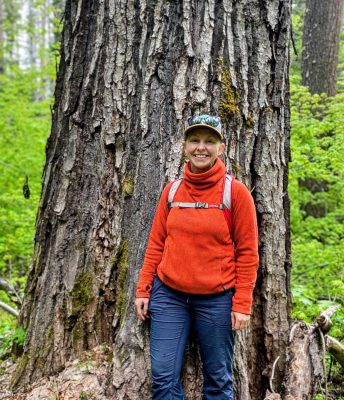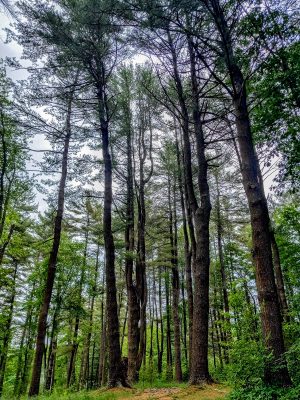Responsible harvesting and other small disturbances can help make forests in the eastern United States more resilient to climate change, according to research by a new University of Wyoming faculty member.
The study by scientists at Cary Institute of Ecosystem Studies—led by Sara Germain, who completed the research as a Cary postdoctoral associate and is now an assistant professor in UW’s Department of Botany—explores how Eastern forests are responding to climate change; how disturbances such as harvesting and pests can help or hinder climate adaptation; and what it all means for carbon storage. The study was published in the journal Ecosystems in January.

Forests of the eastern United States are important carbon storehouses. They remove carbon emissions from the air, packing them away into leaves, trunks, roots, and soils. Eastern forests are responsible for 85 percent of all of the carbon taken up by U.S. forests. And the forests support biodiversity, timber products, and other ecosystem services at the same time.
But Eastern trees are becoming increasingly stressed by warming temperatures, which can slow their growth and reproduction.
“It was comforting to learn that Eastern forests, which hold the most carbon in the U.S., are actually doing OK,” Germain says. “With moderate, status quo levels of disturbance, Eastern forests have the capacity to remain an important carbon sink.”
Much of the research about the potential to leverage forests as a natural climate solution has focused on tropical forests. But study co-author and Cary Institute forest ecologist Charles Canham recognized that Eastern forests—currently rebounding after being cleared for agriculture and logging in previous centuries—are a productive and expanding carbon sink.
The project relies on data from the U.S. Department of Agriculture Forest Inventory and Analysis (FIA) program, which has been surveying forested areas across the U.S. for nearly 100 years to capture trends in forest health, species composition, and use by humans, such as timber harvesting or clearing for agriculture.
FIA data allowed the team to track changes in biomass and forest composition across 22 Eastern states from 1995 to 2021, and how those changes are shaped by disturbances. The team particularly focused on changes in seedling and sapling density for 99 tree species, because young trees are the most vulnerable to heat and drought.
Using the current abundance of seedlings, saplings and adult trees in each plot, the scientists used a model developed by Canham to simulate the forest’s future composition and biomass up to the year 2150. The model simulates trees’ responses to climate, nutrient availability, and competition. It also incorporates natural and human disturbances, including wind, pests and pathogens, and logging, which is the most common disturbance in northeastern forests.
Finding the Forest Management ‘Sweet Spot’
Undisturbed forests tended to contain more species adapted to cool climates, the study found, whereas disturbed forests shifted toward more warm-adapted species. Disturbance appears to clear space for warm-tolerant species to migrate northward.
“Many species become more abundant in the northern portions of their current ranges, and some show northward expansion,” Canham says.

Birch is one species that’s invading more northern habitats and disappearing from its more southern habitats, Germain says.
“There is definitely this movement that’s going on across the landscape, and how forests are changing in any one area is going to depend on the species that are already there, the species that are nearby, and how much disturbance they’ve experienced,” she says.
Because warmer-adapted species are more likely to survive and thrive in a warmer future, the authors conclude that the changes in composition caused by disturbance may support the maintenance of the Eastern forest carbon sink over the long term, by increasing climate resilience.
However, climate resilience may come at a cost to biodiversity and productivity. The diversity of the warm-adapted trees that moved in was lower than the diversity of cold-adapted trees that disappeared. And because young trees are small, they don’t store as much carbon, meaning disturbed forests saw dips in biomass. But those dips are likely temporary.
“It could still lead to more carbon storage in the future if the altered forests are better able to survive in warmer conditions,” Germain explains.
The authors emphasize that the level of disturbance matters, and that they’re not advocating for clearcutting Eastern forests. Severe disturbances can kill off seedlings, reduce carbon storage, and delay forest recovery.
“There was kind of a sweet spot there where low to moderate disturbances initiated the transition to more climate-adapted tree species, but didn’t have the huge losses in carbon that we saw under much more severe disturbances,” says Cary Institute forest ecologist and paper co-author Winslow Hansen.
“It appears that much of eastern forest management is hitting that sweet spot right now,” Germain adds.
Forest managers often must find a balance between competing needs for timber, biodiversity, and carbon storage, and managers at different sites may have different priorities. But overall, Germain says, the results complement a management practice called the triad approach, which divides forest land into a portion managed intensively for timber products; a portion managed for multiple use, including wildlife habitat and recreation; and a portion set aside in reserves.
“People need wood products, and we can’t just stop harvesting altogether,” Germain says. “But, especially in the context of our findings, the triad approach is a good way to balance those different objectives of carbon storage, biodiversity, and forest products.”
This story was originally published on UW News.




